Jenn-Air JDS9860AAP, JDS9860ACP, JDS9860BCP, JDS9861AAP Owner's Manual

JENN-AIR DUAL-FUEL DOWNDRAFT SLIDE-IN RANGE
PROSTYLE
USER
G U I D E
TABLE OF CONTENTS |
|
Safety Instructions ................................................................... |
1-4 |
Ducting Information .................................................................... |
4 |
Surface Cooking ....................................................................... |
5-9 |
Oven Cooking ..................................................................... |
10-17 |
Accessories ................................................................................ |
17 |
Care & Cleaning .................................................................. |
18-20 |
Maintenance ............................................................................... |
21 |
Before You Call for Service ................................................... |
22 |
Warranty .................................................................................... |
23 |
Guide de l’utilisateur................................................................ |
24 |
Guía del Usuario ....................................................................... |
48 |
Form No. B/06/02 Part No. 8113P365-60 74005521 © 2002 Maytag Appliances Sales Co. Litho U.S.A .

Installer: Please leave this manual with this appliance.
Consumer: Please read and keep this manual for future reference. Keep sales receipt and/or cancelled check as proof of purchase.
Model Number
–– –– –– –– –– –– –– –– ––
Serial Number
–– –– –– –– –– –– –– –– ––
Date of Purchase
_______________________________
If you have questions, call:
Jenn-Air Customer Assistance
1-800-688-1100
1-800-688-2080 ( U.S. TTY for hearing or speech impaired)
(Mon.-Fri., 8 am-8 pm Eastern Time)
Internet: http://www.jennair.com
For service information, see page 23.
In our continuing effort to improve the quality and performance of our cooking products, it may be necessary to make changes to the appliance without revising this guide.
IMPORTANT SAFETY INSTRUCTIONS
SAFETY INSTRUCTIONS
Warning and Important Safety Instructions appearing in this guide are not meant to cover all possible conditions and situations that may occur. Common sense, caution, and care must be exercised when installing, maintaining, or operating the appliance.
Always contact your dealer, distributor, service agent, or manufacturer about problems or conditions you do not understand.
RECOGNIZE SAFETY SYMBOLS, WORDS, LABELS
 WARNING
WARNING
WARNING – Hazards or unsafe practices which COULD result in severe personal injury or death.
 CAUTION
CAUTION
CAUTION – Hazards or unsafe practices which COULD result in minor personal injury.
Read and follow all instructions before using this appliance to prevent the potential risk of fire, electric shock, personal injury or damage to the appliance as a result of improper usage of the appliance. Use appliance only for its intended purpose as described in this guide.
To ensure proper and safe operation:
Appliance must be properly installed and grounded by a qualified technician. Do not attempt to adjust, repair, service, or replace any part of your appliance unless it is specifically recommended in this guide. All other servicing should be referred to a qualified servicer. Have the installer show you the location of the gas shut off valve and how to shut it off in an emergency.
Always disconnect power to appliance before servicing.
WARNING: If the information in this manual is not followed exactly, a fire or
explosion may result causing property damage, personal injury or death.
–Do not store or use gasoline or other flammable vapors and liquids in the vicinity of this or any appliance.
–IF YOU SMELL GAS:
•Do not try to light any appliance.
•Do not touch any electrical switch.
•Do not use any phone in your building.
•Immediatelycallyourgassupplierfromaneighbor’sphone. Follow the gas supplier’s instructions.
•If you cannot reach your gas supplier, call the fire department.
–Installation and service must be performed by a qualified installer, service agency or the gas supplier.
 WARNING
WARNING
Because gas may escape from your system which may not be detected by smell alone, resulting in a potentially extremely dangerous situation, it is recommended by gas suppliers that you purchase and install a UL approved gas detector(s) in your home. Your local gas supplier can assist you in obtaining a gas detector. Please install, maintain and use the gas detector in accordance with the gas detector manufacturer’s instructions.
1
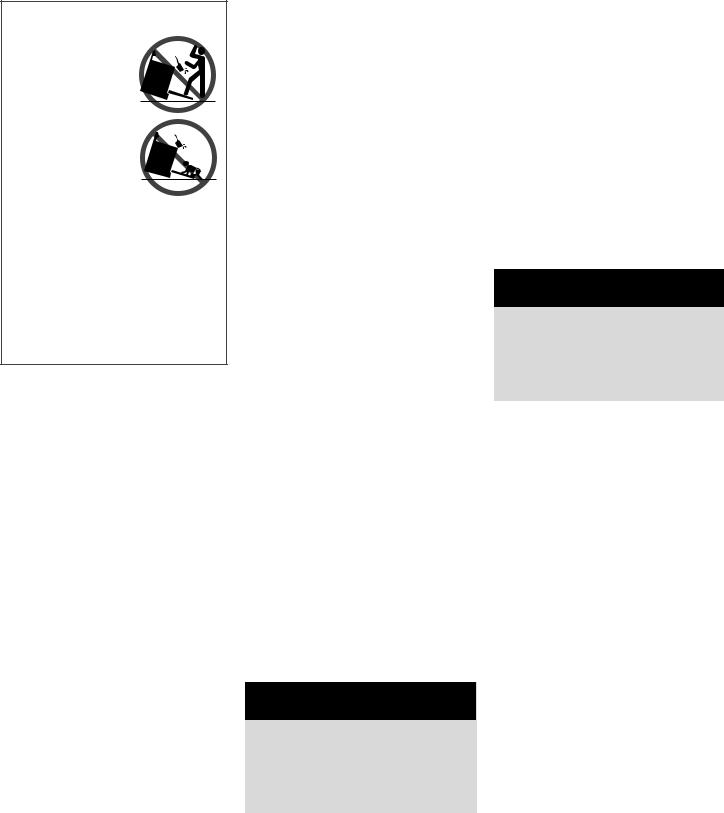
GENERAL
INSTRUCTIONS
 WARNING:
WARNING:
• ALL RANGES
CAN TIP AND
CAUSE INJU-
RIES TO PERSONS
• I N S T A L L ANTI-TIP DEVICE PACKED
WITH RANGE
•FOLLOW ALL INSTALLATION INSTRUCTIONS
To reduce risk of tipping of the appliance from abnormal usage or by excessive loading of the oven door, the appliance must besecuredbyaproperlyinstalled anti-tip device.
To check if device is properly installed, look underneath range with a flashlight to make sure one of the rear leveling legs is properly engaged in the bracket slot. The anti-tip device secures the rear leveling leg to the floor when properly engaged. You should check this anytime the range has been moved.
TO PREVENT FIRE OR SMOKE DAMAGE
Be sure all packing materials are removed from the appliance before operating it.
Keep area around appliance clear and free from combustible materials, gasoline, and other flammable vapors and materials.
If appliance is installed near a window, proper precautions should be taken to prevent curtains from blowing over burners.
NEVER leave any items on the cooktop. The hot air from the vent may ignite flammable items and may increase pressure in
closed containers which may cause them to burst.
Many aerosol-type spray cans are EXPLOSIVE when exposed to heat and may be highly flammable. Avoid their use or storage near an appliance.
Many plastics are vulnerable to heat. Keep plastics away from parts of the appliance that may become warm or hot. Do not leave plastic items on the cooktop as they may melt or soften if left too close to the vent or a lighted surface burner.
To eliminate the hazard of reaching over hot surface burners, cabinet storage should not be provided directly above a unit. If storage is provided, it should be limited to items which are used infrequently and which are safely stored in an area subjected to heat from an appliance. Temperatures may be unsafe for some items, such as volatile liquids, cleaners or aerosol sprays.
IN CASE OF FIRE
Turn off appliance and ventilating hood to avoid spreading the flame. Extinguish flame then turn on hood to remove smoke and odor.
•Cooktop: Smother fire or flame in a pan with a lid or cookie sheet.
NEVER pick up or move a flaming pan.
•Oven: Smother fire or flame by closing the oven door.
Do not use water on grease fires. Use baking soda, a dry chemical or foam-type extinguisher to smother fire or flame.
CHILD SAFETY
 CAUTION
CAUTION
NEVER store items of interest to children in cabinets above an appliance or on backguard of a range. Children climbing on the appliance door to reach items could be seriously injured.
NEVER leave children alone or unsupervised near the appliance when it is in use or is still hot.
NEVER allow children to sit or stand on any part of the appliance as they could be injured or burned.
Children must be taught that the appliance and utensils in it can be hot. Let hot utensils cool in a safe place, out of reach of small children. Children should be taught that an appliance is not a toy. Children should not be allowed to play with controls or other parts of the unit.
ABOUT YOUR
APPLIANCE
 WARNING
WARNING
NEVER use appliance door, or drawer, if equipped, as a step stool or seat as this may result in possible tipping of the appliance, damage to the appliance, and serious injuries.
NEVER use appliance as a space heater to heat or warm a room to prevent potential hazard to the user and damage to the appliance. Also, do not use the cooktop or oven as a storage area for food or cooking utensils.
For proper performance and operation, do not block or obstruct the oven vent duct located on the right side of the air grille.
Avoid touching oven vent area while oven is on and for several minutes after oven is turned off. Some parts of the vent and surrounding area become hot enough to cause burns. After oven is turned off, do not touch the oven vent or surrounding areas until they have had sufficient time to cool.
Other potentially hot surfaces include cooktop, areas facing the cooktop, oven vent, surfaces near the vent opening, oven door, areas around the oven door and oven window.
2

IMPORTANT SAFETY INSTRUCTIONS, CONT.
Do not touch a hot oven light bulb with a damp cloth as the bulb could break. Should the bulb break, disconnect power to the appliance before removing bulb to avoid electrical shock.
COOKING SAFETY
Always place a pan on a surface burner before turning it on. Be sure you know which knob controls which surface burner. Make sure the correct burner is turned on and that the burner has ignited. When cooking is completed, turn burner off before removing pan to prevent exposure to burner flame.
Always adjust surface burner flame so that it does not extend beyond the bottom edge of the pan. An excessive flame is hazardous, wastes energy and may damage the appliance, pan or cabinets above the appliance.
NEVER leave a surface cooking operation unattended especially when using a high heat settingorwhen deepfat frying.Boilovers cause smoking and greasy spillovers may ignite. Clean up greasy spills as soon as possible. Do not use high heat for extended cooking operations.
NEVER heat an unopened container on the surface burner or in the oven. Pressure build-up may cause container to burst resulting in serious personal injury or damage to the appliance.
Use dry, sturdy potholders. Damp potholders may cause burns from steam. Dishtowelsorothersubstitutesshouldnever be used as potholders because they can trail across hot surface burners and ignite or get caught on appliance parts.
Always let quantities of hot fat used for deep fat frying cool before attempting to move or handle.
Do not let cooking grease or other flammable materials accumulate in or near the rangetop or in the vents. Clean frequently to prevent grease from accumulating.
NEVER wear garments made of flammable material or loose fitting or long-sleeved
apparel while cooking. Clothing may ignite or catch utensil handles.
Always place oven racks in the desired positions while oven is cool. Slide oven rack out to add or remove food, using dry, sturdy potholders. Always avoid reaching into the oven to add or remove food. If a rack must be moved while hot, use a dry potholder. Always turn the oven off at the end of cooking.
Use care when opening the oven door. Let hot air or steam escape before moving or replacing food.
NEVER use aluminum foil inside the grill area, to cover oven racks or oven bottom. This could result in risk of electric shock, fire, or damage to the appliance. Use foil only as directed in this guide.
PREPARED FOOD WARNING: Follow food manufacturer’s instructions. If a plastic frozen food container and/or its cover distorts, warps, or is otherwise damaged during cooking, immediately discard the food and its container. The food could be contaminated.
where they are easily hit or reached by small children.
Never let a pan boil dry as this could damage the utensil and the appliance.
Follow the manufacturer’s directions when using oven cooking bags.
Only certain types of glass, glass/ceramic, ceramic or glazed utensils are suitable for cooktop or oven usage without breaking due to the sudden change in temperature. Follow manufacturer’s instructions when using glass.
This appliance has been tested for safe performance using conventional cookware. Do not use any devices or accessories that are not specifically recommended in this guide. Do not use eyelid covers for the surface units, stovetop grills, or add-on oven convection systems. The use of devices or accessories that are not expressly recommended in this manual can create serious safety hazards, result in performance problems, and reduce the life of the components of the appliance.
UTENSIL SAFETY
Use pans with flat bottoms and handles that are easily grasped and stay cool. Avoid using unstable, warped, easily tipped or loosehandled pans. Also avoid using pans, especially small pans, with heavy handles as they could be unstable and easily tip. Pans that are heavy to move when filled with food may also be hazardous.
Be sure utensil is large enough to properly contain food and avoid boilovers. Pan size is particularly important in deep fat frying. Be sure pan will accommodate the volume of food that is to be added as well as the bubble action of fat.
To minimize burns, ignition of flammable materials and spillage due to unintentional contact with the utensil, do not extend handles over adjacent surface burners. Always turn pan handles toward the side or back of the appliance, not out into the room
HEATING ELEMENTS
NEVER touch oven heating elements, areas near elements, or interior surfaces of oven.
Heating elements may be hot even though they are dark in color. Areas near elements and interior surfaces of an oven may become hot enough to cause burns.
During and after use, do not touch or let clothing or other flammable materials contact heating elements, areas near elements, or interior surfaces of oven until they have had sufficient time to cool.
CLEANING SAFETY
Turn off all controls and wait for appliance parts to cool before touching or cleaning them. Do not touch the burner grates or surrounding areas until they have had sufficient time to cool.
3
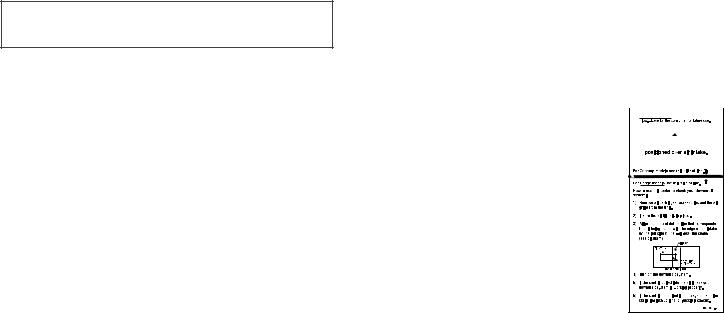
Clean appliance with caution. Use care to |
It is normal for the cooktop of the range to |
avoid steam burns if a wet sponge or cloth |
become hot during a self-clean cycle. There- |
is used to wipe spills on a hot surface. Some |
fore, touching the cooktop during a clean |
cleaners can produce noxious fumes if ap- |
cycle should be avoided. |
plied to a hot surface. |
|
SELF-CLEAN OVEN
Clean only parts listed in this guide. Do not clean door gasket. The door gasket is essential for a good seal. Care should be taken not to rub, damage, or move the gasket. Do not use oven cleaners of any kind in or around any part of the self-clean oven.
Before self-cleaning the oven, remove air grille, broiler pan, oven racks and other utensils and wipe up excessive spillovers to prevent excessive smoke, flare-ups or flaming. CAUTION: Do not leave food or cooking utensils, etc. in the oven during the self-clean cycle.
Slide-in ranges feature a cooling fan which operates automatically during a clean cycle. If the fan does not turn on, cancel the clean operation and contact an authorized servicer.
IMPORTANT SAFETY NOTICE AND WARNING
The California Safe Drinking Water and Toxic Enforcement Act of 1986 (Proposition 65) requires the Governor of California to publish a list of substances known to the State of California to cause cancer or reproductive harm, and requires businesses to warn customers of potential exposures to such substances.
Users of this appliance are hereby warned that the burning of gas can result in lowlevel exposure to some of the listed substances, including benzene, formaldehyde and soot, due primarily to the incomplete combustion of natural gas or liquid petroleum (LP) fuels. Properly adjusted burners
will minimize incomplete combustion. Exposure to these substances can also be minimized by properly venting the burners to the outdoors.
Users of this appliance are hereby warned that when the oven is engaged in the selfclean cycle, there may be some low level exposure to some of the listed substances, including carbon monoxide. Exposure to these substances can be minimized by properly venting the oven to the outdoors during the self-clean cycle by opening a window and/or door in the room where the appliance is located.
IMPORTANTNOTICEREGARDING PET BIRDS: Never keep pet birds in the kitchen or in rooms where the fumes from the kitchen could reach. Birds have a very sensitive respiratory system. Fumes released during an oven self-cleaning cycle may be harmful or fatal to birds. Fumes released due to overheated cooking oil, fat, margarine and overheated non-stick cookware may be equally harmful.
SAVE THESE INSTRUCTIONS FOR FUTURE REFERENCE
DUCTING INFORMATION
Jenn-Air’s ventilation system is designed to capture both cooking fumes and smoke from the cooktop surface. If the system does not, these are some ducting installation situations to check:
•6" diameter round or 3 1/4" x 10" rectangular ducting should be used for duct lengths 10'-60'. Note: 5" diameter round ducting may be used if the duct length is 10' or less.
•No more than three 90° elbows should be used. Distance between elbows should
be at least two and one half times the diameter of the duct.
•Recommended Jenn-Air wall cap MUST be used. Make sure damper moves freely when ventilation system is operating.
•There should be a minimum clearance of 6" for cooktop installed near a side wall.
If there is not an obvious improper installation, there may be a concealed problem such as a pinched joint, obstruction in the pipe, etc. Installation is the responsibility of
the installer and questions should be addressed first by the installer. The installer should very carefully  check the ducting in-
check the ducting in- 



 stallation instructions.
stallation instructions. 





• Use the Flow Tester Card provided with your appliance to check the air flow.
4
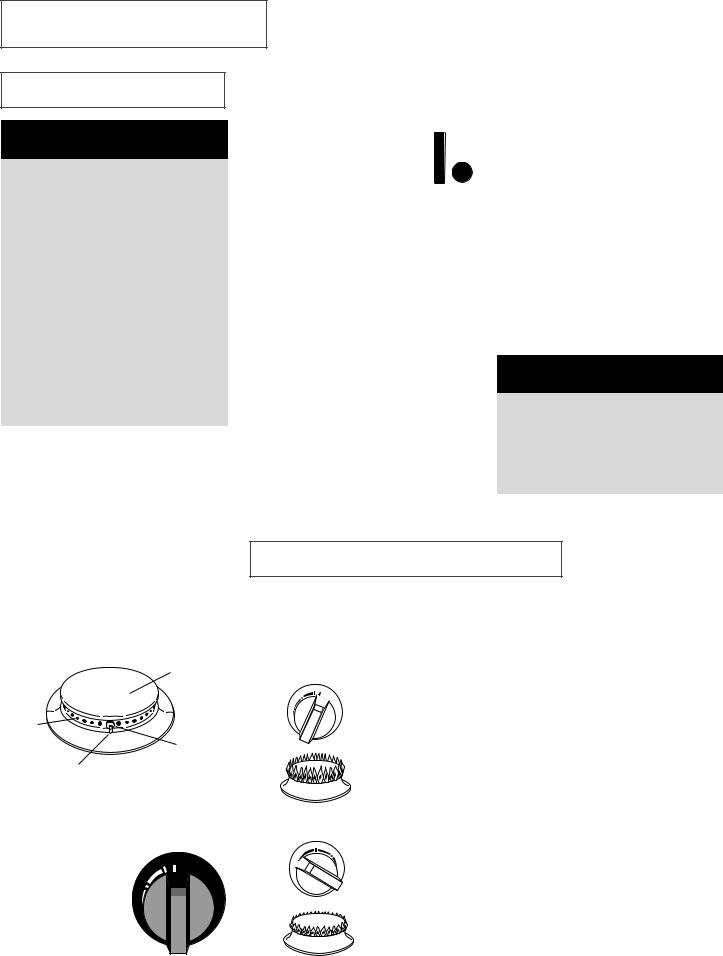
SURFACE COOKING
SURFACE CONTROLS
 CAUTION
CAUTION
•If flame should go out during a cooking operation, turn the burner off. If a strong gas odor is detected, open a window and wait five minutes before relighting the burner.
•Be sure all surface controls are set in the OFF position prior to supplying gas to the range.
•NEVER touch cooktop until it has cooled. Expect some parts of the cooktop, especially around the burners, to become warm or hot during cooking. Use potholders to protect hands.
PILOTLESS IGNITION
Pilotless ignition eliminates the need for a constant standing pilot light. Each surface burner has a spark ignitor. When cleaning around the surface burner use care. If cleaning cloth should catch the ignitor, it could damage it preventing ignition.
knobs can be set on or between any of the settings.
Graphics next to the knob identify which burner the knob controls. For
example, the graphic at right shows the right front burner location.
SETTING THE
CONTROLS
1.Place a pan on the burner grate. (To preserve the grate finish, do not operate the burners without a pan on the grate to absorb the heat from the burner flame.)
2.Push in knob and turn immediately counterclockwise to the lite setting until burner ignites.
•A clicking (spark) sound will be heard and the burner will light. (All ignitors will spark when any surface burner knob is turned to the lite position.)
3.After ignition, turn knob clockwise to desired setting.
•The ignitor will continue to spark until the knob is turned past the lite position.
OPERATING DURING A
POWER FAILURE
1.Hold a lighted match to the desired surface burner head.
2.Push in and turn the control knob slowly to lite.
3.Adjust the flame to the desired level.
 CAUTION
CAUTION
•When lighting the surface burners, be sure all of the controls are in the OFF position. Strike the match first and hold it in position before turning the knob to lite.
SUGGESTED HEAT SETTINGS
If the surface burner does not light, check if ignitor is broken, soiled or wet. If clogged, clean the small port beneath the ignitor using straight pin.
CAP
PORTS
IGNITOR
The size and type of cookware will affect the heat setting. For information on cookware and other factors affecting heat settings, refer to “Cooking Made Simple” booklet.
Settings |
|
Uses |
hi |
|
Use hi to bring liquid to a boil, or reach pressure in a |
e |
|
pressure cooker. Always reduce setting to a lower heat when |
Hi Lite |
|
|
d |
|
|
M |
|
liquids begin to boil or foods begin to cook. |
L |
|
|
o |
|
|
PORT BELOW IGNITOR
SURFACE CONTROL
KNOBS
Use to turn on the surface burners. An infinite choice of heat settings is available from lo to hi. At the hi and lo setting, a detent or notch may be felt. The
i |
Lit |
e |
|
||
H |
|
|
e |
d |
M |
|
o |
|
L |
|
O
f
f
lo
Lo
M e d
|
H |
|
i |
|
L |
e |
ti |
An intermediate flame size is used to continue cooking. Food will not cook any faster when a higher flame setting is used than needed to maintain a gentle boil. Water boils at the same temperature whether boiling gently or vigorously.
Use lo to simmer foods, keep foods warm and melt chocolate or butter.
Some cooking may take place on the lo setting if the pan is covered. It is possible to reduce the heat by rotating the knob toward OFF. Be sure flame is stable.
5
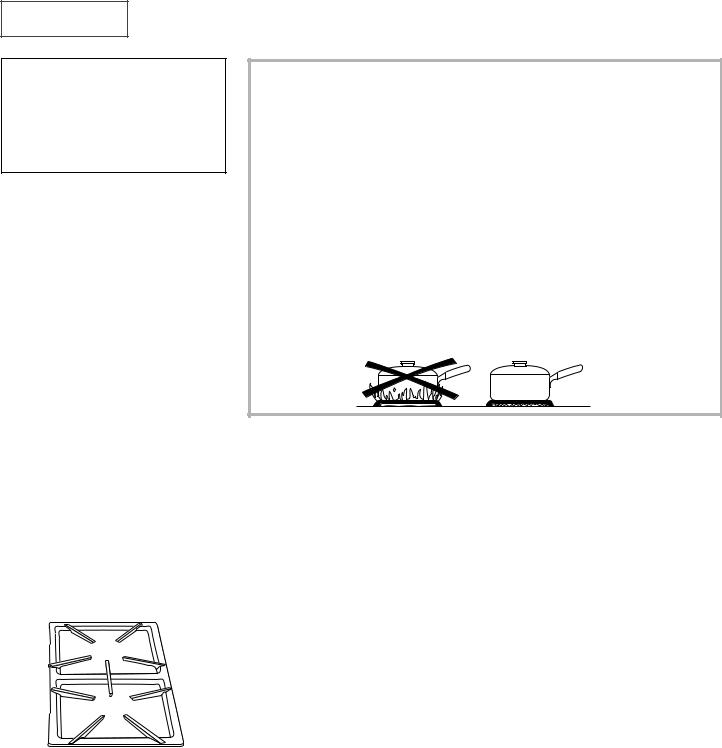
COOKTOP
To prevent the cooktop from discoloring or staining:
•Clean cooktop after each use.
•Wipe acid or sugar spills as soon as the cooktop has cooled.
SEALED BURNERS
The sealed burners on your range are secured to the cooktop cartridge and are not designed to be removed. Since the burners are sealed into the cartridge, boilovers or spills will not seep underneath the cooktop. However, the burner heads should be cleaned after each use.
BURNER GRATES
The grates must be properly positioned before cooking. Improper installation of the grates may result in chipping of the cooktop.
Do not operate the burners without a pan on the grate. The grate’s porcelain finish may chip without a pan to absorbtheheatfromtheburnerflame.
Although the burner grates are durable, they will gradually lose their shine and/or discolor, due to the high temperatures of the gas flame.
NOTES:
•A properly adjusted burner with clean ports will light within a few seconds. If using natural gas, the flame will be blue with a deeper blue inner cone.
If the burner flame is yellow or is noisy, the air/gas mixture may be incorrect. Contact a service technician to adjust. (Adjustments are not covered by the warranty.)
With LP gas, some yellow tips on the flames are acceptable. This is normal and adjustment is not necessary.
•With some types of gas, you may hear a “popping” sound when the surface burner is turned off. This is a normal operating sound of the burner.
•If the control knob is turned very quickly from hi to lo, the flame may go out, particularly if the burner is cold. If this occurs, turn the knob to the OFF position, wait several seconds and relight the burner.
•To improve cooking efficiency and to prevent possible damage to the range or pan, the flame must be adjusted so it does not extend beyond the edge of the pan.
6
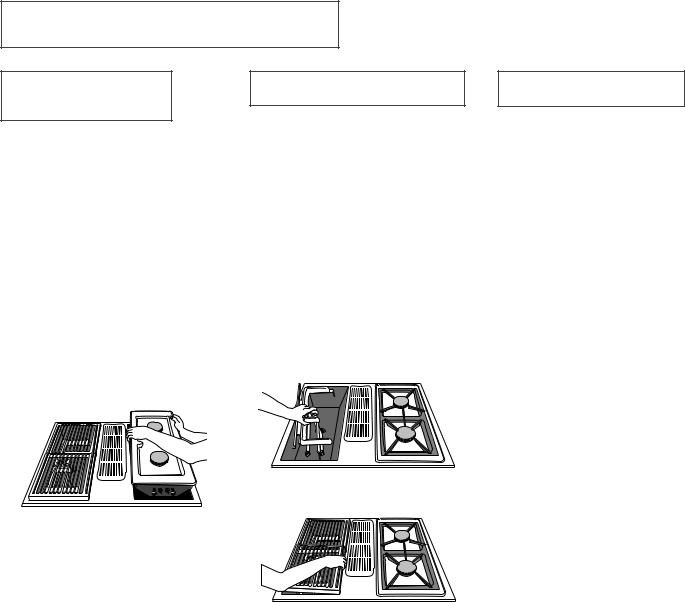
SURFACE COOKING, CONT.
SEALED BURNER
CARTRIDGE
TO INSTALL SEALED BURNER CARTRIDGE:
1. Be sure control knobs are turned OFF.
GRILL INSTALLATION
The grill assembly consists of two grill grates and a grill burner. Only install the grill on the LEFT SIDE of your range.
2.If the grill burner and grill grates are in place, remove before installing a burner cartridge. Clean basin of any grease accumulation. (See page 20 for cleaning recommendations.)
3.Position the burner cartridge with the mixer tube openings and ignitor rods toward the orifices and terminal receptacle. Slide the cartridge until the tubes and ignitors engage, then lower the cartridge so that it rests on the range surface.
TO REMOVE SEALED BURNER CARTRIDGE:
1.Control knobs should be in the OFF position and the range should be cool.
2.Lift up the edge of the cartridge until the bottom of the cartridge clears the basin. (Lifting the cartridge too high while still engaged could damage the ignitor rods and mixer tubes.)
3.To disengage the cartridge, hold by the sides and pull away from the terminal receptacle and orifices. Lift out when fully unplugged.
4.Do not stack cartridges where they may fall or be damaged.
NOTE: Optional Sealed Burner Cartridge, model JGA8100, can replace the grill burner assembly.
TO INSTALL GRILL:
1.Before installing grill components, be sure controls knobs are in the OFF position.
2.Position the grill burner with mixer tubes and ignitor rod toward the orifices and terminal receptacle. Slide the burner until the tubes and ignitor engage, then lower the burner until it rests in the burner basin.
3.Place the grill grates on top of the rangetop.
NOTE: Before using the grill for the first time, heat the grill burner to remove the protective shipping coating. Heat the grill burner on Hi for 10 minutes and use the vent system to remove any smoke.
TO REMOVE GRILL:
1.Be sure control knobs are in the OFF position and the grill components are cool.
2.Remove grill grates.
3.Lift the burner up slightly. Slide the burner away from the orifices and terminal receptacle.
USING THE GRILL
•Before the first use, wash grill grates in hot soapy water, rinse and dry. Then “season” the surface by wiping on a thin coating of cooking oil. Remove excess oil by wiping with paper towel.
Thisprocedureshouldberepeatedwhen either: a) cleaning in the dishwasher since the detergent may remove seasoning or b) anytime a sugar-based marinade (for example, barbecue sauce) is going to be used.
•Preheat the grill on Hi for 5 minutes. Preheating improves the flavor and appearance of meats and quickly sears the meat to help retain the juices.
•Use nonmetallic spatulas or utensils to prevent damaging the nonstick grill grate finish.
•Excessive amounts of fat should be trimmed from meats. Only a normal amount is necessary to produce the smoke needed for that smoked, “outdoor” flavor. Excessive fat can create cleaning and flareup problems.
•Allowing excessive amounts of grease or drippings to constantly flare-up voids the warranty on the grill grates.
•Excessive flare-ups indicate that either the grill interior needs to be cleaned or that excessive amounts of fat are in the meat or the meat was not properly trimmed.
•Grease drippings will occasionally ignite to produce harmless puffs of flame for a second or two. This is a normal part of the cooking process. NOTE: For information on the grease cup, see pg. 20.
•NEVER LEAVE GRILL UNATTENDED DURING GRILL OPERATION.
7
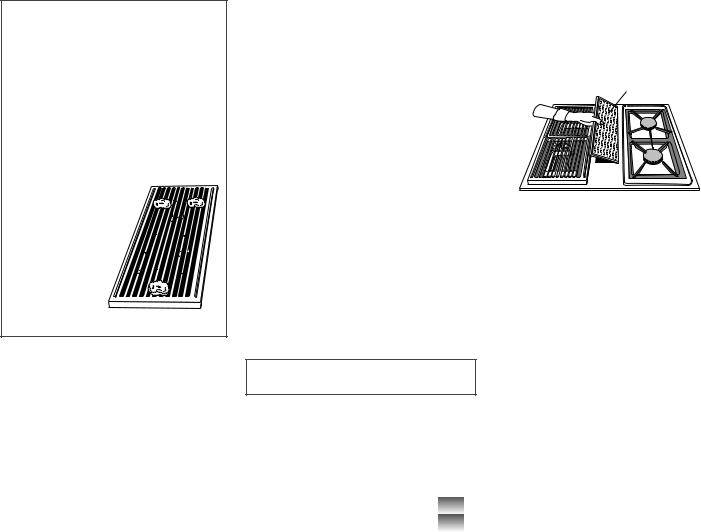
•SHOULD EXCESS GREASE CAUSE SUSTAINED FLAREUPS:
1.Turn on the fan manually.
2.Immediately turn grill controls to
Off.
3.Remove meat from grill.
IMPORTANT
•Do not use aluminum foil inside the grill area.
•Do not use charcoal or wood chips in the grill area.
•Do not allow burner basin to become overloaded with grease. Clean frequently.
•Do not cover grates
completely with meat.  Leave air space be-
Leave air space be- 

 tween each steak,
tween each steak,  etc. to allow
etc. to allow 
 proper ventila-
proper ventila-  tion as well as
tion as well as 

 prevent flare-
prevent flare- 

 ups.
ups.
GRILLING TIPS
•Be sure to follow directions for using the grill.
•Suggested cooking times and control settings (see Grill guide, pg. 9) are approximate due to variations in the foods.
•For best results, buy top grade meat. Meat that is at least 3/4 inch will grill better than thinner cuts.
•Score fat on edges of steak, but do not cut into meat, to prevent curling while cooking.
•For the attractive “branded” look on steaks, be sure grill is preheated. Allow one side of meat to cook to desired
doneness, or until juices appear on the top surface, before turning. Turn steaks and hamburgers just once. Manipulating food causes loss of juices.
•When basting meats or applying sauces to foods, remember that excessive amounts accumulate inside your grill and do not improve the food flavor.
Apply sauces during the last 15 to 20 minutes of cooking time unless recipe specifies otherwise. Plus, anytime a sugarbased marinade (for example barbecue sauce) is going to be used, the grates should be "seasoned" prior to preheating. (See Using the Grill section.)
•There are many meat marinades which will help tenderize less expensive cuts of meat for cooking on the grill.
•Certain foods, such as poultry and nonoily fish, may need some extra fat. Brush with oil or melted butter occasionally while grilling.
•Use tongs with long handles or spatulas for turning meats. Do not use forks as these pierce the meat, allowing juices to be lost.
VENTILATION SYSTEM
The built-in ventilation system removes cooking vapors, odors and smoke from foods prepared on your cooktop and grill.
• To operate the ventilation sys- |
Fan |
|
Hi |
||
tem manually, push the vent |
||
|
||
fan switch located on the con- |
|
|
|
||
trol panel. |
|
|
|
||
Lo |
||
|
•The ventilation system will operate automatically on Hi when the grill burner is in use.
•The fan can be used to remove strong odors from the kitchen as when chopping onions near the fan.
CARE AND CLEANING OF
THE VENTILATION SYSTEM
•Air Grille: The air grille lifts off easily. Wipe clean or wash in dishwasher or sink with mild household detergents. To prevent scratching the surface, do not use abrasive cleaners or scrubbing pads.
•Filter: Turn off ventilation system before removing. The filter is a permanent type and should be cleaned when soiled. Clean in sink with warm water and detergent or
in dishwasher. |
FILTER |
IMPORTANT: DO NOT OPERATE SYSTEM WITHOUT FILTER. Filter should always be placed at an angle. As you face the front of the range, the top of the filter should rest against the left side of the vent opening. The bottom should rest against the right side of the vent chamber at the bottom. (Note: If filter is flat against the fan wall, ventilation effectiveness is reduced.)
•Ventilation Chamber: This area, which houses the filter, should be cleaned in the event of spills or whenever it becomes coated with a film of grease. It can be cleaned with paper towel, damp cloth, or sponge and mild household detergent or cleanser.
OVEN VENT: The oven vent is located under the right side of the air grille. When using or cleaning the oven, hot and moist air may be noticed in this area. When the oven is in use, the vent and surrounding area become hot enough to cause burns. Be careful not to spill anything into this vent. The air grille must be removed before the self-clean cycle.
8

GRILL GUIDE
Preheat grill on Hi 5 minutes, for best flavor.
|
Type |
Setting |
Cooking Time |
Procedure |
|
|
|
|
|
Steak (1/ " - 3/ "): |
|
|
|
|
2 |
4 |
Hi |
6 to 10 minutes |
Turn after 3 to 5 minutes. |
Rare |
|
|||
Medium |
Hi |
10 to 16 minutes |
Turn after 5 to 8 minutes. |
|
Well |
|
Hi |
21 to 24 minutes |
Turn after 6 to 12 minutes. |
Steak (1" - 1 |
1/ "): |
|
|
|
Rare |
4 |
Hi |
14 to 24 minutes |
Turn after 7 to 12 minutes. |
|
||||
Medium |
Hi |
18 to 30 minutes |
Turn after 9 to 15 minutes. |
|
Well |
|
Hi |
24 to 34 minutes |
Turn after 12 to 17 minutes. |
Hamburgers (3-4 oz.) |
Med |
20 to 25 minutes |
Turn after half the time. |
|
Pork Chops |
|
Med |
25 to 45 minutes |
Turn occasionally. |
Fully-cooked |
|
|
|
|
Smoked Pork Chops |
Med |
10 to 15 minutes |
Turn once. Glaze if desired. |
|
Ham Slices |
|
Med |
15 to 20 minutes |
Turn after half the time. |
Fully-cooked Sausages: |
|
|
|
|
Hot Dogs, Brats |
Hi |
7 to 12 minutes |
Turn once. |
|
Polish |
Hi |
13 to 16 minutes |
Turn occasionally. |
|
Fresh Sausage: |
|
|
|
|
Links |
|
Med |
15 to 25 minutes |
Turn occasionally. |
Patties (3" dia.) |
Med |
15 to 20 minutes |
Turn after half the time |
|
Italian |
Med |
25 to 30 minutes |
Pierce casing with a fork. |
|
|
|
|
|
Turn once. |
Chicken: |
|
|
|
|
Pieces:Bone-in |
Med |
30 to 50 minutes |
Turn occasionally. |
|
Breasts: Boneless |
Med |
20 to 30 minutes |
Turn occasionally. |
|
Fish: |
|
|
|
|
Steaks (1") |
Med |
20 to 25 minutes |
Brush with butter. Turn after |
|
|
|
|
|
half the time. |
Fillets (1/ ") |
Med |
10 to 15 minutes |
Start skin side down. Brush |
|
|
2 |
|
|
with butter. |
(with skin on) |
|
|
||
|
|
|
|
Turn after half the time. |
Shrimp: (skewered) |
Med |
10 to 20 minutes |
Turn and brush with butter or |
|
|
|
|
|
marinade frequently. |
Garlic Bread |
Med |
4 to 6 minutes |
Turn after half the time. |
|
Hot Dog Buns, |
|
|
|
|
Hamburger Buns |
Med |
1 to 2 minutes |
|
|
|
|
|
|
|
Note: This chart is a suggested guide. Cooking times and control settings are approximate due to variations in meats and gas pressure.
9
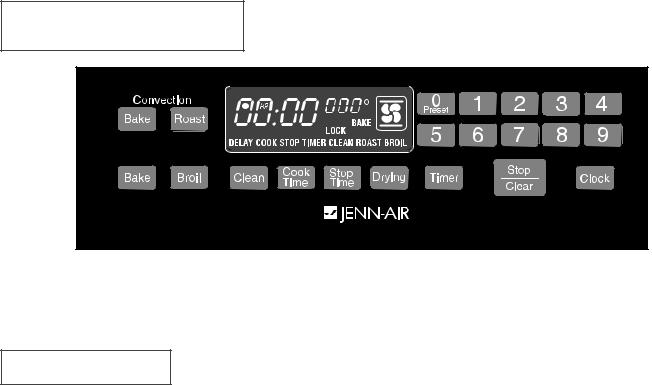
OVEN COOKING
The control panel is designed for ease in programming. The display window on the electronic control shows time of day, timer and oven functions. Indicator words flash to prompt your programming steps. NOTE: Styling and features may differ slightly depending on the model. Control panel shown includes convection bake and drying functions.
FUNCTION PADS
•Press the desired pad.
•Press the appropriate number pads to enter time or temperature.
BAKE
Use for conventional baking or roasting.
1.Press Bake pad.
2.Press Preset (0) pad for 350°F or the appropriate number pads for desired temperature.
3.If more or less cleaning is desired, press the appropriate number pads. Cleaning time may be set between 2 and 4 hours.
See page 18-19 for additional information.
CONVECT BAKE
•A beep will sound when any pad is pressed.
•A double beep will sound if a programming error occurs.
NOTE: Four seconds after entering the number, the time or temperature will automatically be entered. If more than 30 seconds elapse between touching a function pad and the number pads, the function will be canceled and the display will return to the previous display.
NUMBER PADS
Use to set time or temperature.
STOP/CLEAR
Use to cancel all programming except Clock and Timer functions.
See page 13 for additional information.
BROIL
Use for top browning and broiling.
1.Press Broil pad.
2.Press Preset (0) pad for HI broil, press again for LO broil, or press the appropriate number pads to set desired broil temperature.
See page 14 for additional information.
CLEAN
Use to set self–clean cycle.
1.Press Clean pad.
2.Press Preset (0) pad for “3:00” hours of cleaning time.
Use for convection baking.
1.Press Convect Bake pad.
2.Press Preset (0) pad for 325°F or the appropriate number pads for desired temperature.
See page 13 for additional information.
CONVECT ROAST
Use for convection roasting.
1.Press Convect Roast pad.
2.Press Preset (0) pad for 325°F or the appropriate number pads for desired temperature.
See page 13 for additional information.
10

OVEN COOKING, CONT.
COOK TIME/STOP TIME |
SETTING THE TIMER |
Use to program the oven to start and stop automatically.
1.Press Bake, Convect Bake, or Convect Roast pad. Press the appropriate number pads for desired temperature.
2.Press Cook Time pad. Press the appropriate number pads to enter cooking time in hours and minutes.
3.To delay the start of cooking, press Stop Time pad. Press the appropriate number pads to enter the time you want the oven to stop.
See page 14-15 for additional information.
DRYING
Use to dry or dehydrate foods such as fruits, vegetables and herbs.
1.Press Drying pad.
2.Press Preset (0) pad for 140°F or the appropriate number pads for the drying temperature desired.
See page 15-16 for additional information.
SETTING THE CLOCK
1.Press Clock pad.
•The indicator word TIME will flash in the display.
2.Press the appropriate number pads until the correct time of day appears in the display.
When electrical power is supplied or after a power interruption, the last clock time, before power was interrupted, will flash.
To recall the time of day when another time function is showing, press the Clock pad.
Clock time cannot be changed when the oven has been programmed for clock controlled cooking, self-clean or delayed selfclean.
Use to set and then signal the completion of a time period up to 99 hours and 59 minutes.
The timer can be used independently of any other oven activity and can be set while another oven function is operating. The timer does not control the oven.
1.Press Timer pad.
•The indicator word TIMER will flash and “0Hr:00” appears in the display.
2.Press the appropriate number pads until the desired number of minutes or hours and minutes appear in the display.
Example: To set the Timer for 5 minutes, press the Timer pad and the number 5 pad. The control will begin countdown after a four second delay.
0 HR :05 BAKE
DELAY COOK STOP TIMER CLEAN ROAST BROIL
Example: To set the Timer for 1 hour and 30 minutes, press the Timer pad and the numbers 1,3,0 pads. The control will begin countdown after a four second delay.
1 HR:30 BAKE
DELAY COOK STOP TIMER CLEAN ROAST BROIL
3. The last minute of the countdown will be displayed as seconds.
4. At the end of the time set, the timer will beep and “End” will appear in the display. To change the number of timer beeps and add reminder beeps, see next column.
TO CANCEL:
1.Press and hold Timer pad for three seconds. The time of day will reappear.
OR
2.Press the Timer pad and the “0” number pad. After a slight delay the time of day will reappear.
NOTE: Pressing Stop/Clear pad to cancel the timer will cancel ALL selected oven functions except the clock and timer.
CONTROL OPTIONS
CONTROL LOCKOUT OPTION
The control touchpads can be locked to prevent unwanted use. They will not function when locked.
If an oven function is currently being used, the controls cannot be locked.
The current time of day will remain in the display when this feature is activated.
SETTING CONTROL LOCKOUT:
1.Press and hold the Stop Time and the Stop/Clear pads at the same time for three seconds.
•The indicator word OFF will appear in the display for 15 seconds. OFF will reappear for 15 seconds if any pad is pressed.
TO CANCEL:
Press and hold the Stop Time and the Stop/Clear pads at the same time for three seconds. The indicator word OFF will disappear in the display.
TIMER BEEP OPTIONS
•Option 1: One long beep at the end of the timer operation, then, one short beep every 30 seconds for the next five minutes or until the Stop/Clear pad is pressed.
•Option 2: One long beep at the end of the timer operation, then, one short beep every minute for the next 12
11
hours or until the Stop/Clear pad is pressed.
•Option 3 (default option): One beep at the end of the timer operation, then, no other beeps.
SETTING THE TIMER BEEPS:
1.Press the Timer and Stop/Clear pads at the same time and hold for three seconds.
•A single beep will sound.
•Display will show the indicator word TIMER and the current option.
2.Press the appropriate number pad (1, 2, or 3) to select the option you wish. The current time of day will reappear in the display after four seconds.
CLOCK CONTROLLED OVEN
COOKING BEEP OPTIONS
•Option 1 (default option): Four beeps at the end of cooking, then, one beep every 30 seconds for the next five minutes or until the Stop/Clear pad is pressed.
•Option 2: Four beeps at the end of cooking, then, one beep every minute for the next 12 hours or until the Stop/ Clear pad is pressed.
•Option 3: Four beeps at the end of cooking, then, no other beeps.
SETTING CLOCK CONTROLLED OVEN COOKING BEEPS:
1.Press Cook Time and Stop/Clear pads at the same time and hold for three seconds.
•A single beep will sound.
•Display will show the indicator word COOK and the current option.
2.Press the appropriate number pad (1, 2, or 3) to select the option you wish. The current time of day will reappear in the display after four seconds.
CANCEL CLOCK DISPLAY
OPTION
If you prefer that the time of day not be displayed:
1.Press Clock and Stop/Clear pads at the same time and hold for three seconds.
2.Press Clock pad to briefly recall the time of day, if desired.
TO RESTORE:
Press the Clock and Stop/Clear pads at the same time and hold for three seconds. The time of day will reappear in the display.
AUTOMATIC OVEN TURN
OFF OPTION
The oven will automatically turn off after 12 hours, if you accidentally leave it on. You can deactivate this feature, if desired.
TO ELIMINATE 12 HOUR TURN OFF:
1.Press the Clock pad and hold for three seconds or until “12” appears in the display. The indicator word TIME will flash in the display.
2. Press any number pad until 8888 appears in the display. Current time of day will reappear in the display after four seconds.
TO RESTORE:
Press the Clock pad and hold for three seconds or until 8888 appears. Press “1” number pad. “12” will appear briefly in the display followed by the current time of day.
OVEN TEMPERATURE
ADJUSTMENT OPTION
If you think the oven should be hotter or cooler, you can adjust it yourself. To decide how much to change the thermostat, set the oven temperature 25°F higher or lower than the temperature in your recipe, then bake. The results of the “test” should give you an idea of how much to adjust the thermostat.
TO ADJUST THE THERMOSTAT:
1.Press the Bake pad.
2.Enter 550° F by pressing the number pads “5, 5, 0.”
3.Press and hold the Bake pad for several seconds until 0° appears in the display.
4.Press any number pad to change the
temperature. Eachtime a pad ispressed, the temperature changes by 5°F.
•Press repeatedly to reach +35°F.
Continue pressing to reduce the temperature up to -35°F.
5.When you have made the adjustment, press the Stop/Clear pad and the time of day will reappear in the display. The oven will now bake at the adjusted temperature.
NOTE: It is not recommended to adjust the temperature if only one or two recipes are in question.
It is not necessary to readjust the oven temperature if there is a power interruption. This adjustment will not affect broil or clean temperatures.
12
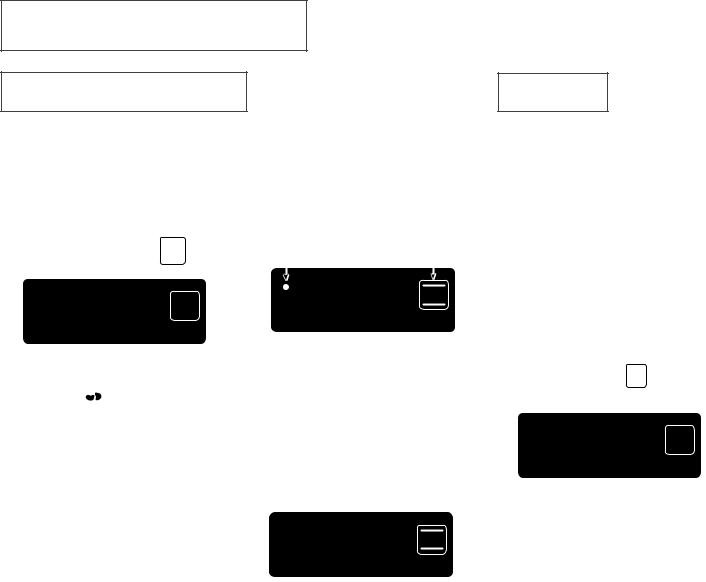
OVEN COOKING, CONT.
BAKING AND ROASTING
1.Place oven racks on proper rack positions. (See page 17.)
2.Press Bake, Convect Bake or Convect Roast pad.
•The indicator word BAKE will flash.
•000 and the oven icon 
 will appear.
will appear.
–and 100° or the actual oven temperature, whichever is higher, will appear in the display.
–when convection cooking the fan icon will begin to rotate.
PREHEAT |
BAKE |
INDICATOR |
ICON |
5:30 |
0 0 0 |
5:30 |
1 0 0 |
BAKE |
|||
BAKE |
|
|
•When convection cooking is selected, a fan icon  will also appear.
will also appear.
3.Press the Preset (0) pad to set 350°F
automatically. When convection cooking, 325°F will be automatically set when Preset (0) is pressed. Or press the appropriate number pads for the desired oven temperature.
•The temperature can be set from 100° to 550° F.
•After four seconds the oven will begin to heat.
–the bake icon (top and bottom bars) will light;
–a red preheat indicator will light;
•The temperature in the display will increase in 5° increments until the oven reaches the preset temperature.
•When the oven is preheated, the oven will beep and the preheat indicator light will go off in the display. Allow 7–14 minutes for the oven to preheat.
5:40 3 5 0
BAKE
4.At the end of cooking, turn the oven off by pressing the Stop/Clear pad. Remove food from oven. The oven will continue operating until theStop/Clear pad is pressed.
BROILING
Broil in the oven cavity. For best results, use a pan designed for broiling.
For additional broiling tips, refer to the
“Cooking Made Simple” booklet.
SETTING THE CONTROLS FOR
BROILING
1.Place the oven rack on the proper rack position.
2.Press the Broil pad.
•The indicator word BROIL will flash. 000 and the oven  icon will appear.
icon will appear.
5:30 0 0 0
BROIL
3.Press the Preset (0) pad to enter HI broil. Press again to set LO broil.
•The oven has a variable broil feature which means a specific broil temperature can be selected. To select a specific temperature, press the appropriate number pads for the temperature desired after 000 appears in the display.
NOTES: |
|
• |
To change the oven temperature during |
Baking time will be the same or a |
|
BAKING AND ROASTING |
|
|
cooking, press the appropriate Bake, |
few minutes less than the direc- |
|
|
|
Convect Bake or Convect Roast pad |
tions. |
||
|
|
|
|
||
• |
If more than 30 seconds elapse be- |
|
and the appropriate number pads for the |
• When convection roasting, roast- |
|
|
tween pressing a function pad |
and |
|
desired oven temperature. |
|
|
|
ing times are generally 25–30% |
|||
|
pressing a number pad, the display will |
|
|
||
|
• |
You may find that the cooking times and |
less. (Maintain conventional roasting |
||
|
return to the previous display. |
|
|||
|
|
|
temperatures vary slightly from your old |
temperatures.) |
|
|
|
|
|
||
• |
To recall the set temperature during |
|
oven. This is normal. Every oven has its |
• See roasting chart in “Cooking Made |
|
|
preheat, press the appropriate Bake, |
|
own characteristics. |
||
|
|
Simple” booklet for recommended |
|||
|
Convect Bake or Convect Roast |
|
As a general rule, when convection |
||
|
• |
roasting temperature and times. |
|||
|
pad. The set temperature will be dis- |
||||
|
|
baking, set the oven temperature |
• For additional baking, roasting and con- |
||
|
|
|
|
||
|
played briefly and then return to the |
|
25° F lower than the conventional |
||
|
|
vection cooking tips, see “Cooking |
|||
|
ongoing program. |
|
|
||
|
|
|
|
recipe or prepared mix directions. |
Made Simple” booklet. |
|
|
|
|
|
|
|
|
|
|
|
|
13
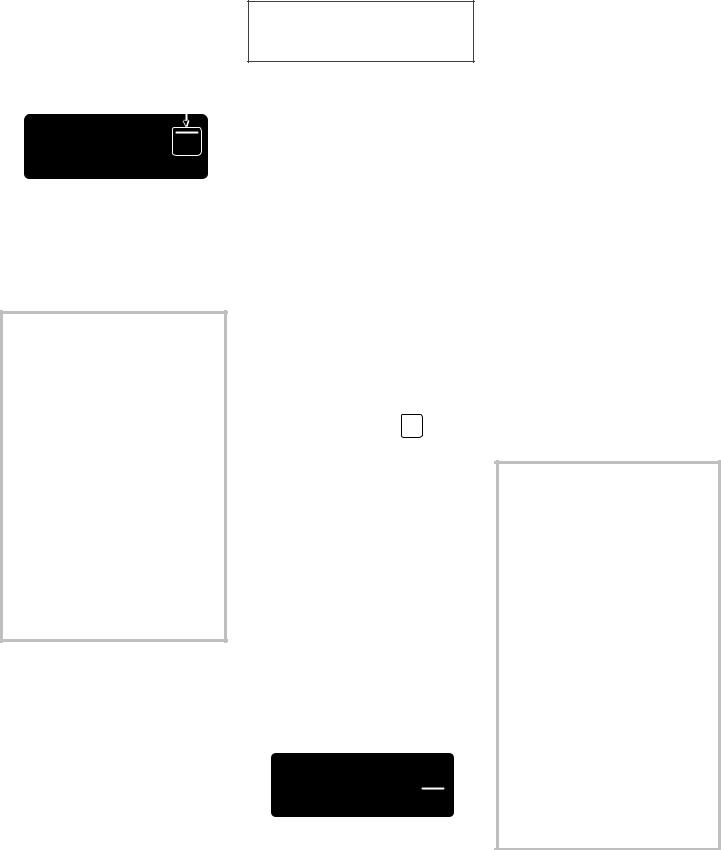
•Four seconds after entering HI, LO or a temperature, the broil icon will come on and the indicator word BROIL will remain in the display.
BROIL
ICON
5:30 H I
BROIL
4.Place food in the oven leaving the oven door open to the first stop position (about 4 inches).
5.Press the Stop/Clear pad to turn off oven when food is cooked.
NOTES:
BROILING
•Hi broil is used for most broiling. Use lo broil when broiling longer cooking foods to allow them to cook to well done without excessive browning.
•A cooling fan will automatically turn on during broiling. If it does not operate, contact an authorized servicer.
•Never cover broiler pan insert with aluminum foil. This prevents fat from draining to the pan below.
•Expect broil times to be longer and browning to be slightly lighter if appliance is installed on a 208 volt circuit.
CLOCK CONTROLLED
OVEN COOKING
Use to program the oven to start and stop automatically.
The clock must be functioning and set at the correct time of day for this feature to operate correctly.
The feature can be used with either oven cooking or self-cleaning. See pages 18-19 for instructions on delaying the start of a clean cycle.
SETTING THE CONTROLS
TO START IMMEDIATELY AND TURN OFF AUTOMATICALLY:
1.Press the Bake, Convect Bake or Convect Roast pad.
•The indicator word BAKE will flash.
•000 and the oven icon  will appear.
will appear.
•When convection cooking is selected, a fan icon will also appear.
will also appear.
2.Press the Preset (0) pad to set 350°F. (When convection cooking, 325°F will be automatically set.) Or press the appropriate number pads for the desired oven temperature.
3.Press the Cook Time pad. The indicator words COOK TIME will flash and the display will show “0HR:00”.
4.Press appropriate number pads to enter cooking hours and minutes.
Example: If cooking time selected for baking is 2 hours and 30 minutes, the display will show:
2 HR :30 1 0 0 ° 
BAKE
DELAY COOK STOP TIMER CLEAN ROAST BROIL
5.At the end of the programmed Cook Time, the oven will shut off automatically, “End” will appear in the display and a beep will be heard four times. Press the Stop/Clear pad.
If the program is not cancelled, there will be one beep every 30 seconds for five minutes. (If you wish to change the beeps at the end of clock controlled cooking, see page 12.)
TO DELAY THE START AND TURN OFF AUTOMATICALLY:
1–4. Follow preceding steps 1–4.
5.Press the Stop Time pad. Indicator words STOP and TIME will flash. Display will show the calculated stop time based on the current time of day and the cook time that you entered previously.
6.Press the appropriate pads to enter the time you wish the oven to stop. A stop time can only be accepted for later in the day. cont.
NOTES:
CLOCK CONTROLLED
OVEN COOKING
•If more than 30 seconds elapse between pressing a function pad and pressing the appropriate number pads, the oven is NOT set and display will return to the previous display.
•Highly perishable foods such as dairy products, pork, poultry or seafood are not recommended for delayed cook operations.
•Clock controlled baking is not recommended for baked items that require a preheated oven, such as cakes, cookies, pies and breads.
•Cook time can be set for up to 11 hours and 59 minutes (11:59).
14
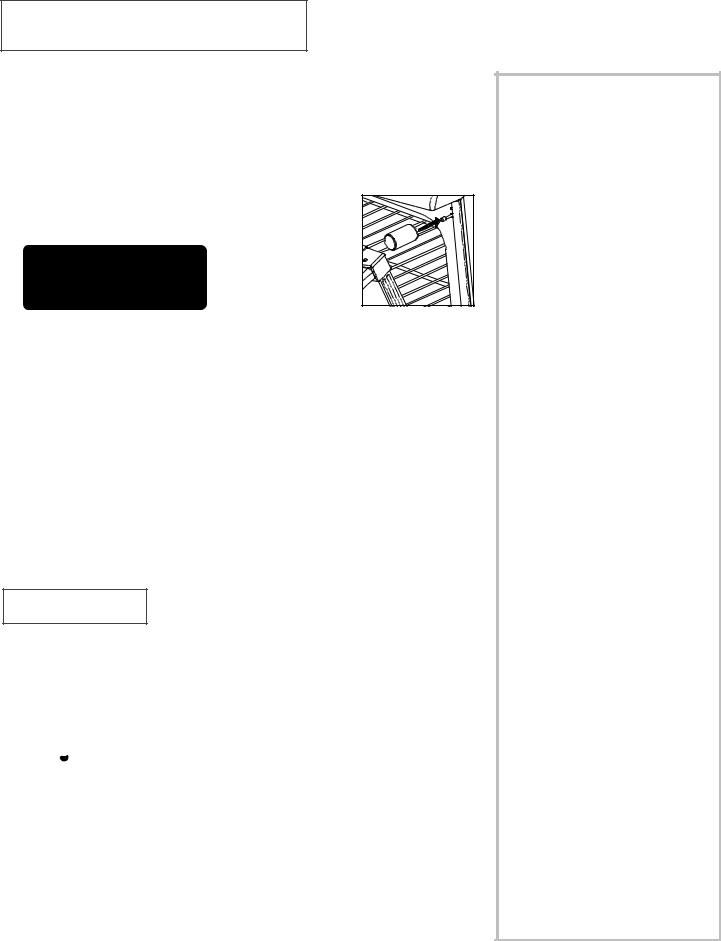
OVEN COOKING, CONT.
Example: If at 10:00 you set the oven for 350°F and 2 hours and 30 minutes of cooking time, the calculated stop time would be “12:30”.
If you want the stop time to be 1:00, press the number pads “1,0,0”. Four seconds later, the display will show 1:00 along with the indicator words DELAY, STOP TIME.
1 :00 BAKE 
DELAY COOK STOP TIMER CLEAN ROAST BROIL
7.At the end of the delayed period, the DELAY indicator word will go off and the oven will begin to heat.
8.At the end of the clock controlled Cook Time, the oven will shut off automatically, “End” will appear in the display and a beep will be heard four times. Press the Stop/Clear pad.
If the program is not cancelled, there will be one beep every 30 seconds for five minutes. (If you wish to change the beeps at the end of clock controlled cooking, see page 12.)
DRYING PAD
For drying fruits, vegetables, herbs, etc. Use a drying rack for best results. It allows air to circulate evenly around the foods.
1.Press the Drying pad.
•000, the oven icon and convection fan icon  will appear.
will appear.
2.Press the Preset (0) pad for 140°F or press the appropriate number pads for the desired drying temperature.
•The temperature may be set between 100°-200°F.
•If the temperature is set for under 100°F or over 200°F, the control will beep twice and default to 100°F or 200°F respectively.
3.The oven door needs to be opened slightly to allow moisture to escape from the oven during the drying process.
•Open the oven door slightly.
•Place the magnetic door spacer (Part No. 8010P146-60) over the plunger switch at the
upper right side of the oven frame.
The spacer provides a gap between the
oven frame and the oven door allowing moisture to escape.
•Gently close the door until the spacer magnet makes contact with the oven door. The magnet will hold the spacer in the proper position during the drying process and allows the door to be opened at any time during drying without losing proper positioning.
NOTE: If the spacer is not placed correctly, the convection fan will not operate.
Follow the drying guide on page 16 for drying times. Cool foods to room temperature before testing for doneness.
4.When drying is complete, turn the oven off by pressing the Cancel pad. Using a potholder, remove the magnetic spacer.
NOTE:Please keep the magnetic spacer in a safe and convenient place for easy access. To replace, call 1-800-688-8408 to order Part No. 8010P146-60.
NOTE: If moisture collects around the oven vent area, remove the air grille during the drying operation.
NOTES:
DRYING
•To purchase a drying rack, contact your Jenn-Air dealer for the “DRYINGRACK” Accessory Kit or call 1-800-688-8408.
•Most fruits and vegetables dry well
and retain their color when dried at 140° F. For optimal flavor, dry herbs at 100° F, however, at this lower temperature expect extended drying times of up to 8 hours.
•The length of drying times vary due to the following: Water and sugar content of food, size of food pieces, amount of food being dried, humidity in the air.
•Check foods at the minimum drying time. Dry longer if necessary.
•More than one rack of food may be dried at the same time. However, additional drying time is needed.
•Fruits that turn brown when exposed to air should be treated with an antioxidant. Try one of the following methods:
1.Dip fruit in a mixture of two parts bottled lemon juice to one part cool water.
2.Soak fruit in a solution of 1 tsp. ascorbic acid or commercial antioxidant to 1 quart of cold water.
•Foods may drip during the drying process. After drying high acid or sugary foods, clean the oven bottom with soap and water. The porcelain oven finish may discolor if acid or sugary food soils are not wiped up prior to high heat or a self-cleaning cycle.
•Refer to other resources at your local library or call your local County Extension service for additional information.
15

DRYING GUIDE
|
|
|
Approx. |
Fruits |
Varieties Best for Drying |
Preparation |
Drying Time Test for Doneness |
|
|
|
at 140°F ** |
Apples* |
Firm varieties: Graven |
|
Stein, Granny Smith, |
|
Jonathan, Winesap, |
|
Rome Beauty, Newton |
Apricots* |
Blenheim/Royal most |
|
common. Tilton also good |
Bananas* |
Firm varieties |
Cherries |
Lambert, Royal Ann, |
|
Napoleon, Van or Bing |
Nectarines |
Freestone varieties |
and Peaches* |
|
Pears* Bartlett
Pineapple |
Fresh or canned |
Orange and Select rough-skinned fruit Lemon Peel Do not dry the peel of fruit
marked “color added”
Vegetables
Wash, peel if desired, core and slice |
4-8 hours |
Pliable to crisp. Dried |
into 1/8” slices. |
|
apples store best when they |
|
|
are slightly crisp. |
Wash, halve, and remove pits. |
18-24 hours |
Soft, pliable. |
Peel and cut into 1/4” slices. |
17-24 hours. |
Pliable to crisp. |
Wash and remove stems. Halve and |
18-24 hours. |
Pliable and leathery. |
remove pits. |
|
|
Halve and remove pits. Peeling is |
24-36 hours |
Pliable and leathery. |
optional but results in better-looking |
|
|
dried fruit. |
|
|
Peel, halve and core. |
24-36 hours |
Soft and pliable. |
Wash, peel and remove thorny eyes. |
Canned: |
Soft and pliable. |
Slice length wise and remove the small |
14-18 hours |
|
core. Cut crosswise into 1/2” slices. |
Fresh: |
|
|
12-16 hours |
|
Wash well. Thinly peel the outer 1/16 |
1-2 hours |
Tough to brittle. |
to 1/8” of the peel. Do not use the |
|
|
white bitter pith under the peel. |
|
|
|
|
|
Tomatoes |
Plum, Roma |
Halve, remove seeds. Place tomatoes |
12-18 hours |
Tough to crisp. |
|
|
skin side up on rack. Prick skins. |
|
|
Carrots |
Danvers Half Long, |
Do not use carrots with woody fiber or |
4-8 hours |
Tough to brittle. |
|
Imperator, Red Cored |
pithy core. Wash, trim tops and peel if |
|
|
|
Chantenay |
desired. Slice crosswise or diagonally |
|
|
|
|
in 1/4” slices. Steam blanch for 3 min. |
|
|
Hot Peppers |
Ancho, Anaheim |
Wash, halve and seed. Prick |
4-6 hours |
Pods should appear shriveled, |
|
|
skin several times. |
|
dark red and crisp. |
|
|
|
|
|
Herbs |
|
|
|
|
|
|
|
|
|
Parsley, Mint, |
|
Rinse in cold water. Leave stems on |
1-3 hours |
Brittle and crumbly. |
Cilantro, Sage, |
|
until leaves are dry, then discard. |
|
|
Oregano |
|
|
|
|
Basil |
|
Cut leaves 3 to 4” from top of plant |
2-5 hours |
Brittle and crumbly. |
|
|
just as buds appear. Rinse leaves in |
|
|
|
|
cold water. |
|
|
|
|
|
|
|
*Fruits requiring an antioxidant to prevent discoloration and loss of nutrients. Refer to the notes on page 15 for specific methods.
** 12 Hour Off will not occur during drying functions.
16
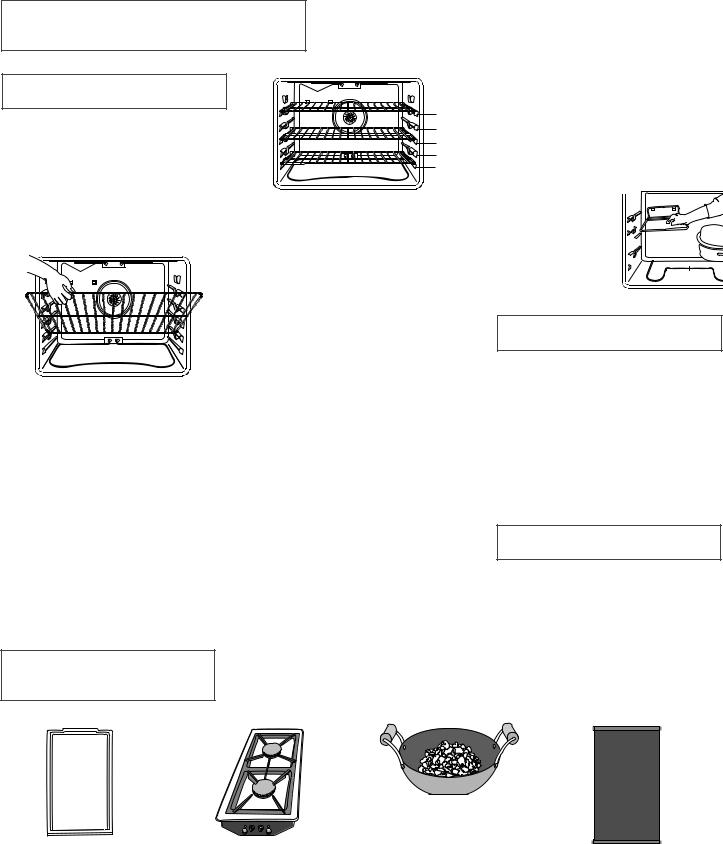
OVEN COOKING, CONT.
OVEN RACKS
The oven has three racks. All racks are designed with a lock-stop edge.
TO REMOVE OVEN RACKS:
Pull rack straight out until it stops at the lock-stop position; lift up on the front of the rack and pull out.
TO REPLACE OVEN RACKS:
Place rack on the rack support in the oven; tilt the front end up slightly; slide rack back until it clears the lock-stop position; lower front and slide back into the oven.
5
4
3
2
1
Three-rack Convection
Baking (Racks 1, 3 and 5)
RACK 4:
Use for two-rack baking and for broiling.
RACK 3:
Use for most baked goods on a cookie sheet or jelly roll pan, layer cakes, fruit pies, or frozen convenience foods, and for broiling.
RACK 2:
Use for roasting small cuts of meat, casseroles, baking loaves of bread, bundt cakes or custard pies, and two-rack baking.
RACK 1:
Use for roasting large cuts of meat and poultry, frozen pies, dessert souffles or angel food cake, and two-rack baking.
RACK POSITIONS
RACK 5:
Use for toasting bread or broiling very thin foods.
MULTIPLE RACK COOKING:
Two rack: Use rack positions 2 and 4, or 1 and 4.
Three rack: (convection functions only) Use rack positions 1, 3 and 5. See illustration.
HALF RACK ACCESSORY
A half rack, to increase oven capacity, is available as an accessory. It fits in the left, upper portion of the oven and provides space for a vegetable dish when a large roaster is on the lower  rack. Contact your
rack. Contact your 
 Jenn-Air dealer for the
Jenn-Air dealer for the 

 “HALFRACK” Acces-
“HALFRACK” Acces- 

 sory Kit or call 1-800-
sory Kit or call 1-800- 
 688-8408.
688-8408. 
COOLING FAN
The cooling fan will automatically turn on during cleaning, broiling and some baking operations. It is used to keep internal parts on the control panel cool. The fan will automatically turn off when parts have cooled. The fan may continue to operate after the oven has been turned off. This is normal.
OVEN LIGHT
The oven light automatically comes on when the door is opened. When the door is closed, press the Oven Light switch on the control panel to turn the light on or off.
ACCESSORIES
Gas Griddle – AG302
Self-draining griddle makes many favorite foods easier to fix. Fam- ily-sized surface lets you cook several pancakes, hamburgers, or grilled sandwiches at a time. Has a black non-stick finish.
|
Wok Accessory – AO142 |
|
Sealed Burner Module – |
Ideal for stir frying, steaming, |
|
braising, and stewing. Wok has |
||
JGA8100ADB (black) |
nonstick finish, wood handles, |
|
JGA8100ADW (white) |
cover, steaming rack, rice |
|
The grill assembly can be re- |
paddles and cooking tips. Flat |
|
bottom wok can be used on |
||
moved and a sealed burner car- |
||
ALL cartridges. |
||
tridge can be installed. |
||
|
Grill Cover – AG341
Attractive grill cover protects grill when not in use. Textured steel in black or white with molded handles.
17
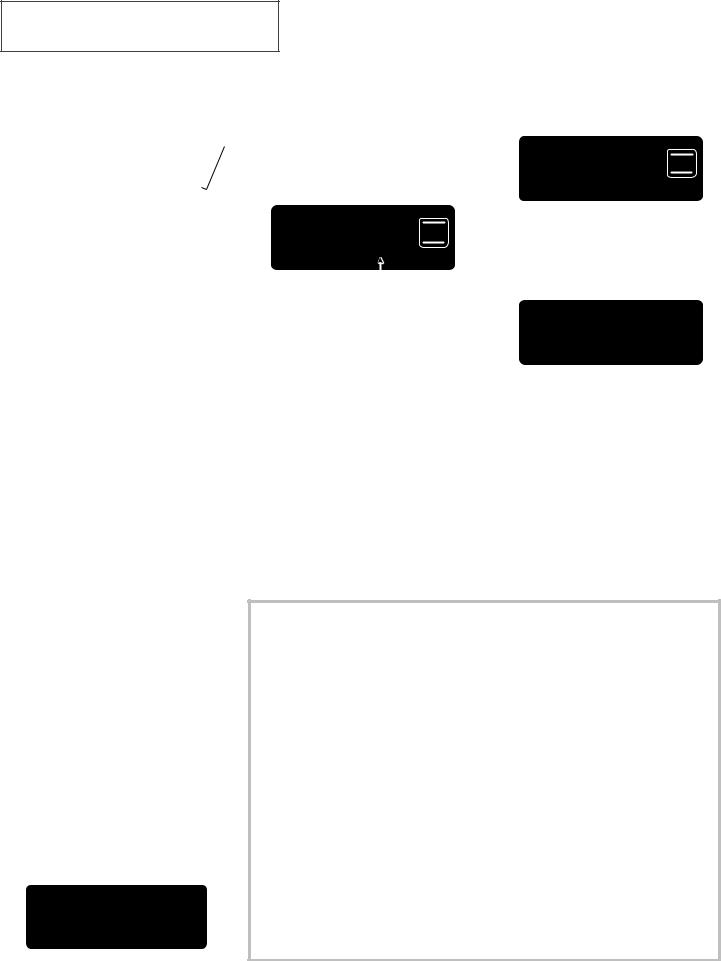
CARE & CLEANING
CLEAN PAD
•Clean oven frame, door frame (area
outside of gas-
ket) and around the
opening in the door gasket with a nonabrasive cleaner such as Bon Ami*. These areas are not exposed to cleaning temperatures.
•Remove oven racks. If racks are left in during a clean cycle, it may impair function and they will discolor. Turn off the oven light and close door.
•Remove air grille.
* Brand names for cleaning products are registered trademarks of the respective manufacturers.
SETTING THE CONTROLS FOR A SELF–CLEAN CYCLE:
1.Close the oven door.
2.Press the Clean pad.
•The indicator word CLEAN will flash.
The display will show “– – : – –” along with the oven icon  .
.
•If the door has not been closed, the display will show “door”.
3.Press Preset (0) pad for “3:00” hours of cleaning time for an average soiled oven.
•The cleaning time can be varied depending on the amount of soil. Press the appropriate number pads to set any amount of time between 2 and 4 hours. “2:00” hours of cleaning for light soil, up to “4:00” hours of cleaning for heavy soil.
•Four seconds after entering the cleaning time, the oven door will automatically lock. The indicator word LOCK will appear in the display along with the clean icon (top and bottom bars).
4 :00 BAKE 
LOCK
DELAY COOK STOP TIME CLEAN ROAST BROIL
4.When the cleaning time has been completed, the indicator word CLEAN will turn off. The indicator word LOCK will remain on until the oven has cooled. When the oven has cooled, the indicator word LOCK will turn off and the door will automatically unlock.
10 :00 |
BAKE |
|
LOCK |
DELAY COOK STOP TIME |
BROIL |
Automatic lock is still engaged. Door cannot be opened until LOCK is no longer displayed.
TO DELAY THE START OF A CLEAN CYCLE:
1–3. Follow steps 1–3.
4.Press the Stop Time pad. Indicator words STOP TIME will flash in the display and the calculated stop time will also appear in the display.
5.Press the appropriate number pads to enter the stop time you desire. (A stop time can only be accepted for later in the day.)
Example: If at 9:00 you set the oven to
clean for three hours, the calculated stop time would be “12:00”. The display will show:
12:00
LOCK
DELAY COOK STOP TIMER CLEAN ROAST BROIL
If you want the stop time to be 1:00, press the number pads “1,0,0”. Four seconds later the display will show 1:00 and the indicator word DELAY.
1 :00 BAKE 
LOCK
DELAY COOK STOP TIMER CLEAN ROAST BROIL
6.When the oven begins to clean, the clean icon (top and bottom bars) will come on. The indicator word DELAY will go off.
7.When the clean time has been completed, the indicator word CLEAN will turn off. The indicator word LOCK will remain on until the oven has cooled. When the oven has cooled, the indicator word LOCK will turn off and the door will automatically unlock.
cont.
NOTES:
• |
To prevent damage to oven door, do |
|
become hot during a clean cycle. Avoid |
|
not attempt to open oven door when |
|
touching cooktop, door, window or oven |
|
the LOCK indicator word is displayed. |
|
vent area during a clean cycle. |
• |
During the cleaning process, the kitchen |
• |
A cooling fan will automatically turn on |
|
should be well ventilated to help elimi- |
|
during cleaning. If it does not operate, |
|
nate normal odors associated with clean- |
|
contact an authorized servicer. |
|
ing. Odors will lessen with use. |
• |
Wipe up sugary and acidic spillovers |
|
|
||
• |
It is normal for flare-ups, smoking or |
|
such as sweet potatoes, tomato or milk- |
|
flaming to occur during cleaning if the |
|
based sauces prior to a self-clean cycle. |
|
oven is heavily soiled. It is better to |
|
Porcelain enamel is acid resistant, not |
|
clean the oven regularly rather than to |
|
acid proof and may discolor if spills are |
|
wait until there is a heavy buildup of soil. |
|
not wiped up before a self-clean cycle. |
• |
Wipe up excess grease or spillovers to |
• |
A white discoloration may appear after |
|
prevent flare-ups. For ease in cleaning, |
|
cleaning if acidic or sugary foods are not |
|
the bake element in the oven can be |
|
wiped up before the clean cycle. This |
|
lifted slightly (1 inch). |
|
discoloration is normal and will NOT |
• |
It is normal for parts of the range to |
|
affect performance. |
|
|
18

CARE & CLEANING, CONT.
TO CANCEL SELF–CLEAN:
1.Press the Stop/Clear pad. The door will be locked while the LOCK indicator word remains in the display.
Depending on the length of time the oven had been cleaning, it may take up to an hour for the oven to cool down. When the oven is cool, the door will automatically unlock and it can be opened.
CLEANING
PROCEDURES
•Moderate/Heavy Soil –– Wipe with one of the following - Bon Ami, Smart Cleanser, or Soft Scrub* - using a damp sponge or soft cloth. Rinse and dry. Stubborn soils may be removed with a damp Scotch-Brite* pad; rub evenly with the grain. Rinse and dry. To restore luster and remove streaks, follow with Stainless Steel Magic Spray.
•Discoloration –– Using a damp sponge or soft cloth, wipe with Cameo Stainless Steel Cleaner*. Rinse immediately and dry. To remove streaks and restore luster, follow with Stainless Steel Magic Spray.
ACCESS PANEL
 CAUTION
CAUTION
•Be sure appliance is off and all parts are cool before handling or cleaning. This is to avoid damage and possible burns.
•To prevent staining or discoloration, clean appliance after each use.
•If a part is removed, be sure it is correctly replaced.
STAINLESS STEEL
•DO NOT USE ANY CLEANING PRODUCT CONTAINING CHLORINE BLEACH.
•ALWAYS WIPE WITH THE GRAIN WHEN CLEANING.
•Daily Cleaning/Light Soil –– Wipe with one of the following - soapy water, white vinegar/water solution, Formula 409 Glass and Surface Cleaner* or a similar glass cleaner - using a sponge or soft cloth. Rinse and dry. To polish and help prevent fingerprints, follow with Stainless Steel Magic Spray (Jenn-Air Model A912, Part No. 20000008)**.
The access panel is easily opened or removed. To open panel, grasp upper corners and pull forward and down. To close panel, lift up and insert prongs into catches in the range.
PRONGSS
GREASE
CUP
•Wash with soap and water, a glass cleaner or mild liquid sprays.
•Do not use excessive amounts of water.
•To prevent scratching or dulling of the finish, do not use mildly abrasive, abrasive, harsh or caustic cleaners such as oven cleaners.
NOTE: To avoid the possibility of accidentally disconnecting any part of the ventilation system, do not use the area behind the access panel for storage.
BROILER PAN AND INSERT
•Place soapy cloth over insert and pan; let soak to loosen soil.
•Wash in warm soapy water. Use scouring pad to remove stubborn soil.
•Broiler pan and insert can be cleaned in dishwasher.
CLOCK AND CONTROL
PANEL AND PAD AREA
•To activate “Control Lock” for cleaning, see page 11.
•Wipe with a damp cloth and dry.
•Glass cleaners may be used if sprayed on a cloth first. DO NOT spray directly on control pad and display area.
CONTROL KNOBS
•Remove knobs in the OFF position by pulling forward.
•Wash, rinse and dry. Do not use abrasive cleaning agents as they may scratch the finish.
•Turn on each burner to be sure the knobs have been correctly replaced.
SEALED GAS BURNER
CARTRIDGE -PORCELAIN
ENAMEL
Porcelain enamel is glass fused on metal and may crack or chip with misuse. It is acid resistant, not acid proof. All spillovers, especially acid or sugar spillovers, should be wiped up immediately with a dry cloth.
•When cool, wash with soapy water, rinse and dry.
•Never wipe off a warm or hot surface with a damp cloth. This may cause cracking or chipping.
•Never use oven cleaners, abrasive or caustic cleaning agents on exterior finish of range.
* Brand names for cleaning products are registered trademarks of the respective manufacturers. ** To order direct, call 1-800-688-8408.
19

OVEN WINDOW – GLASS
•Avoid using excessive amounts of water which may seep under or behind glass causing staining.
•Wash with soap and water. Rinse with clear water and dry. Glass cleaner can be used if sprayed on a cloth first.
•Do not use abrasive materials such as scouring pads, steel wool or powdered cleaners as they will scratch glass.
OVEN RACKS
•Clean with soapy water.
•Remove stubborn soil with cleansing powder or soap-filled scouring pad. Rinse and dry.
•If over time, racks do not slide out easily, wipe the rack edge and rack support with a small amount of vegetable oil to restore ease of movement, then wipe off excess oil. Likewise, place one drop of vegetable oil on rack guides.
NOTE: Remove oven racks during a clean cycle. If racks are left in the oven, it may impair function and they will discolor.
OVEN INTERIORS
•Follow instructions on page 18 to set a self-clean cycle.
SEALED GAS BURNER
ASSEMBLY
•Allow burner and grates to cool. Wash with soapy water and a plastic scouring pad. For stubborn soils, clean with a soap-filled, nonabrasive pad or a sponge and a commercial Cooktop Cleaning Creme (Part #20000001)**.
•Clean gas ports with a soft bristle brush or straight pin, especially the port below
the ignitor. Do not enlarge or distort holes.
•Be careful not to get water into burner ports.
•When cleaning, use care to prevent damage to the ignitor. If the ignitor is soiled, wet or damaged the surface burner will not light.
GRILL ASSEMBLY –
BASIN – PORCELAIN
The basin is located under the grill burner and/or cartridges. Clean after each use of the grill.
•To remove light soil, clean with soapy water or spray with cleansers such as Fantastik* or Formula 409*. For easier cleanup: a) spray with a household cleanser; b) cover with paper towels; c) add small amount of hot water to keep the paper towels moist; d) cover and wait 15 minutes; and e) wipe clean.
•To remove moderate soil, scrub with Bon Ami*, a soft scrub cleanser or plastic scrubber.
Note: Check the grease drain after each use of the grill or grill accessories. To clean: Pour about 1/3 cup of very hot tap water mixed with 1 teaspoon dish detergent down the drain.
GRATES – CAST ALUMINUM
COATED WITH NON-STICK
FINISH
•Wash cool grates (DO NOT IMMERSE HOT GRILL GRATES IN WATER) with detergent in hot water in the sink or wash them in the dishwasher. Be sure to remove all food residue before cooking on the grill grates again.
•Remove stubborn soils with a plastic mesh puff or pad. Use only those cleaning products which state they are recommended for use when cleaning nonstick surfaces.
•If grates were washed in the dishwasher, season with oil prior to grilling.
•Do not use metal brushes or abrasive scouring pads or other scrubbers intended to clean outdoor charcoal grills. These will remove the finish as well as scratch the grates. Do not clean in self-cleaning oven or use oven cleaners on the grates.
GRILL BURNER
•Follow instructions on page 7 for removing the grill burner.
•The grill burner should be cleaned after each use with a soapy S.O.S.* pad or in the dishwasher. Rinse and dry thoroughly before using again.
NOTE: Check to be sure all burner ports are open. To open clogged ports, insert a straight pin into each port.
GREASE CUP
•The container is located on the left side behind the bottom access panel, underneath the range. (See page 19 for opening access panel.) It collects grease and other liquids created while grilling. Check each time after grilling and empty when grease is noticeable. To remove, simply grasp the handle, and pull from the bracket holding the container.
•The container can be washed in hot, soapy water or in the dishwasher.
* Brand names for cleaning products are registered trademarks of the respective manufacturers. ** To order direct, call 1-800-688-8408.
20

MAINTENANCE
OVEN DOOR
 CAUTION
CAUTION
•NEVER place excessive weight on or stand on an open oven door. This could cause the range to tip over, break the door, or injure the user.
•NEVER attempt to open or close door or operate oven until door is properly replaced.
•NEVER place fingers between hinge and front oven frame. Hinge arms are spring mounted. If accidentally hit, the hinge will slam shut against oven frame and could injure your fingers.
TO REMOVE:
1.When cool, open the oven door to the broil stop position (opened about four inches).
2.Grasp door at each side. Do not use the door handle to lift door.
3.Lift up evenly until door clears hinge
arms.
TO REPLACE:
1.Grasp door at each side.
2.Align slots in the door with the hinge arms on the range.
3.Slide the door down onto the hinge arms until the door is completely seated on the hinges. Push down on the top corners of the door to completely seat door on hinges. Door should not appear crooked.
NOTE: The oven door on a new range may feel “spongy” when it is closed. This is normal and will decrease with use.
OVEN WINDOW
TO PROTECT THE OVEN DOOR WINDOW:
1.Do not hit the glass with pots, pans, furniture, toys, or other objects.
2Do not close the oven door until the oven racks are in place.
Scratching, hitting, jarring or stressing the glass may weaken its structure causing an increased risk of breakage at a later date.
LEVELING LEGS
• Be sure the anti-tip bracket secures one of the rear leveling legs to the floor. This bracket prevents the range from accidentally tipping.
The range should be leveled when installed. If the range is not level, turn the plastic leveling legs, located at each corner of the  range, until
range, until 
ANTI-TIP-TIPBRACKETBRACKET
range is level.
 LEVELING LEG
LEVELING LEG
LEVELING LEG
REMOVING RANGE FOR
CLEANING & SERVICE
1.Shut off gas supply to appliance.
2.Disconnect electrical supply to appliance.
3.Disconnect blower system.
4.Disconnect gas supply tubing to appliance.
5.Slide range forward to disengage from anti-tip bracket. (See Installation Instructions for location of bracket.)
6.Reverse procedure to reinstall. If gas line has been disconnected, check for gas leaks after reconnection. NOTE: A qualified servicer should disconnect and reconnect gas supply.
7.To prevent accidental tipping, range must be secured to the floor by sliding rear leveling leg into anti-tip bracket.
OVEN LIGHT
To assure the proper replacement bulb is used, order bulb from Maytag Customer Service. Call 1-800-688-8408, ask for part number 74004458 - halogen bulb.
 CAUTION
CAUTION
•Disconnect power to range before replacing light bulb.
•Allow oven to cool before replacing light bulb.
•Make sure bulb cover and bulb are cool before touching.
TO REPLACE OVEN LIGHT BULB:
1.When oven is cool, use fingertips to grasp edge of bulb cover. Pull out and remove.
2.Carefully remove old bulb by pulling straight out of ceramic base.
3.To avoid damaging or decreasing the life of the new bulb, do not touch the bulb with bare hands or fingers. Hold with a cloth or paper towel. Push new bulb prongs straight into small holes of ceramic base.
4.Replace bulb cover by snapping into place.
5.Reconnect power to the range. Reset clock.
21
